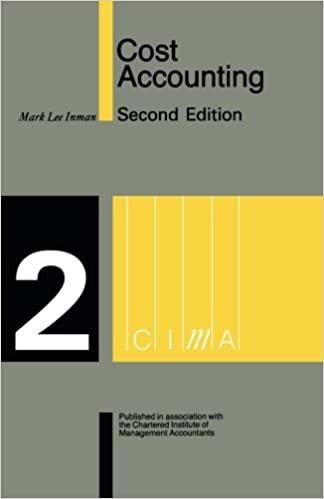Question
Problem 1) The management of VITULLO Company is trying to decide whether to continue manufacturing a part or to buy it from an outside supplier.
Problem 1)
The management of VITULLO Company is trying to decide whether to continue manufacturing a part or to buy it from an outside supplier. The part, called FIZBE, is a component of the companys finished product.
The following information was collected from the accounting records and production data for the year ending December 31, 2017.
- 5,000 units of FIZBE were produced in the machining department.
- Variable manufacturing costs applicable to the production each FIZBE unit were: direct materials $4.75, direct labor $4.60, Indirect labor $0.45, utilities $0.35.
- Fixed manufacturing costs applicable to the production of FIZBE were:
| COST | DIRECT | ALLOCATED |
| Depreciation | $1,100 | $900 |
| Property Taxes | 500 | 200 |
| Insurance | 900_____ | 600_____ |
|
| $2500 | $1700 |
All variable manufacturing and direct fixed costs will be eliminated if FIZBE is purchased. Allocated costs will have to be absorbed by other production departments.
- The lowest quotation for 5,000 FIZBE units from a supplier is $56,000.
- If FIZBE units are purchased, freight and inspection costs would be $0.30 per unit, and receiving costs totaling $500 per year would be incurred by the Machining Department.
Instructions
- Prepare an incremental analysis for FIZBE. Your analysis should have columns for (1) Make FIZBE, (2) Buy FIZBE, and (3) Net Income Increase/Decrease.
- Based on your analysis, what decision should management make?
- Would the decision be different if VITULLO Company has the opportunity to produce $6,000 of net income with the facilities currently being used to manufacture FIZBE? Show Computations.
- What nonfinancial factors should management consider in making its decision?
Problem 2)
Panda Corporation has four operating divisions. During the first quarter of 2014, the company reported aggregate income from operations of $129,000 and the divisional results shown below.
Division
|
| I____ | ___II____ | _III____ | IV____ |
| Sales | $510,000 | $400,000 | $310,000 | $170,000 |
| Cost of Goods Sold | 300,000 | 250,000 | 270,000 | 156,000 |
| Selling and Administration Expenses | 60,000 | 80,000 | 75,000 | 70,000 |
| Income (loss) from operations | $150,000 | $70,000 | $(35,000) | $(56,000) |
Analysis Reveals the following percentages of variable costs in each division.
Division
|
| I____ | ___II____ | _III____ | IV____ |
| Cost of Goods Sold | 70% | 80% | 70% | 90% |
| Selling and Administration Expenses | 40% | 50% | 60% | 70% |
Discontinuance of any division would save 50% of the fixed costs and expenses for that division.
Top management is very concerned about the unprofitable divisions (III and IV). Consensus is that one or both of the divisions should be discontinued.
Instructions
- Compute contribution margin for Divisions III and IV.
- Prepare an incremental analysis concerning the possible discontinuance of (1) Division III and (2) Division IV. What course of action do you recommend for each division?
Extra Credit
- Prepare a columnar condensed income statement for Panda Corporation, assuming Division IV is eliminated. (Use the CVP format). Division IVs unavoidable fixed costs are allocated equally to the continuing divisions.
- Reconcile the total income from operations ($129,000) with the total income from operations without Division IV.
Step by Step Solution
There are 3 Steps involved in it
Step: 1

Get Instant Access to Expert-Tailored Solutions
See step-by-step solutions with expert insights and AI powered tools for academic success
Step: 2

Step: 3

Ace Your Homework with AI
Get the answers you need in no time with our AI-driven, step-by-step assistance
Get Started


